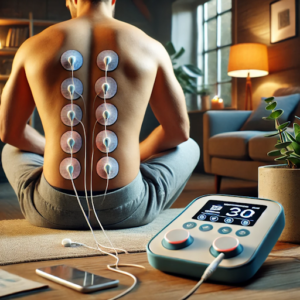Effectively Managing Back Pain Through Electrotherapy
Back pain is a widespread issue affecting millions worldwide, transcending age, gender, and lifestyle factors. It can manifest in various ways, from sharp discomfort lasting a few days to chronic pain that persists for months or years. Often, back pain stems from a combination of physical, psychological, and environmental factors.
Common causes of back pain include muscle strain, herniated discs, arthritis, and poor posture. The variability in how back pain is experienced complicates diagnosis and treatment. While some may find the pain tolerable, others could be severely debilitated, requiring a comprehensive approach from healthcare professionals.
Beyond physical health, chronic back pain can take a toll on emotional well-being, often leading to anxiety, depression, and social isolation. The economic implications are substantial, as back pain is one of the leading causes of disability and reduced productivity in workplaces.
Understanding the underlying causes of back pain is crucial for developing effective treatment strategies. One such strategy is electrotherapy, which has gained recognition for its ability to relieve pain and promote recovery.
Summary
- Back pain may result from factors like poor posture, muscle strain, or injury and significantly impact daily life.
- Electrotherapy is a non-invasive technique that uses electrical energy to manage pain and promote healing.
- Electrotherapy offers pain relief, muscle relaxation, improved circulation, and reduced inflammation.
- Different electrotherapy methods like TENS and EMS can help alleviate back pain.
- When using electrotherapy, it’s important to follow healthcare professional advice and avoid using it near the heart or on broken skin.
 Introduction to Electrotherapy
Introduction to Electrotherapy
Electrotherapy refers to various techniques that use electrical energy to treat conditions like back pain. This therapeutic approach has evolved, utilizing advanced technologies to offer pain relief and promote healing. Electrotherapy can target specific areas of discomfort by stimulating nerves and muscles through electrical impulses.
Unlike medications, which may cause side effects or dependency, electrotherapy is non-invasive and effective in managing back pain. As research continues, the benefits of electrotherapy are becoming more widely recognized, leading to its integration into comprehensive pain management plans.
Benefits of Electrotherapy for Back Pain
One of the primary benefits of electrotherapy is its ability to provide immediate pain relief. Elect electrotherapy interrupts pain signals by sending electrical impulses to the affected area, reducing discomfort.
Additionally, it promotes the release of endorphins, the body’s natural pain relievers, further enhancing its effectiveness. Electrotherapy also improves blood circulation and reduces inflammation, supporting the healing process. This combination of immediate and long-term benefits makes electrotherapy a valuable tool for managing back pain.
Types of Electrotherapy for Back Pain
Electrotherapy encompasses various methods, each targeting different aspects of back pain management. TENS (Transcutaneous Electrical Nerve Stimulation) is a popular technique that delivers low-voltage electrical currents to relieve pain. Its portability and ease of use make it ideal for home treatment.
IFC (Interferential Current Therapy) uses medium-frequency electrical currents to reach deeper tissues and address musculoskeletal issues. Additionally, EMS (Electrical Muscle Stimulation) and microcurrent therapy are increasingly recognized for stimulating muscle contractions and aiding tissue repair.
 How to Use Electrotherapy for Back Pain Management
How to Use Electrotherapy for Back Pain Management
Following specific guidelines is crucial to ensuring safety and effectiveness when using electrotherapy. Patients should consult a healthcare provider to determine the best electrotherapy option. Once a treatment plan is in place, therapy can be administered in a clinical setting or with portable devices at home.
Home users must follow the manufacturer’s instructions for electrode placement, intensity, and session duration. A typical session lasts between 20 and 60 minutes. Consistency is key, as regular treatments offer cumulative benefits over time. Regular communication with a healthcare provider is essential to track progress and make adjustments if needed.
Precautions and Considerations When Using Electrotherapy
Although electrotherapy is generally safe, certain precautions should be taken to avoid complications. Individuals with heart disease, epilepsy, or implanted devices like pacemakers should consult a healthcare provider before using electrotherapy. Pregnant women are also advised to avoid electrotherapy near the abdomen or lower back.
It is important to avoid placing electrodes on open wounds or infected areas. Patients should also monitor their bodies for adverse reactions during treatment and stop immediately if they experience increased pain or skin irritation.
 Integrating Electrotherapy with Other Back Pain Management Techniques
Integrating Electrotherapy with Other Back Pain Management Techniques
Integrating electrotherapy with other treatments can enhance back pain management. A holistic approach often yields better results than relying on a single therapy. Combining electrotherapy with physical therapy can strengthen muscles and improve flexibility while addressing underlying musculoskeletal problems.
Making ergonomic adjustments at work or home can further enhance the benefits of electrotherapy by reducing strain on the back. Additionally, incorporating stress-reducing practices like yoga or meditation can help alleviate pain perception by promoting relaxation.
FAQs
Can you tell me about electrotherapy for back pain?
Electrotherapy uses electrical stimulation to manage and relieve back pain—standard methods in inStandardTENS and EMS.
How might electrotherapy help with my back pain?
Electrotherapy stimulates nerves and muscles to improve blood flow, promote healing, block pain signals, and trigger the production of endorphins, the body’s natural painkillers.
Is it safe to use electrotherapy for back pain?
Electrotherapy is generally safe when guided by a trained healthcare provider. Follow recommended protocols and avoid applying the device near the head or heart.
How does electrotherapy work for back pain?
Electrotherapy relieves pain, reduces muscle spasms, and improves flexibility. It’s a non-invasive and drug-free option for managing back pain.
Who can benefit from electrotherapy for back pain?
Electrotherapy may benefit individuals with conditions such as strained muscles, arthritis, sciatica, or herniated discs as part of a broader pain management strategy.
Are there any situations where electrotherapy isn’t recommended?
Electrotherapy is not recommended for individuals with pacemakers, epilepsy, or heart conditions. Consult a doctor before starting treatment.
Brought To You By: Back Pain Therapy
The Article: Managing Back Pain with Electrotherapy appeared first on https://mcrtherapies.co.uk
The Article Managing Back Pain with Electrotherapy appeared first on https://mcrtherapies.com
The Article Managing Back Pain with Electrotherapy Was Found On https://limitsofstrategy.com


Your examination of back pain and its management through electrotherapy highlights the multifaceted nature of this issue, and I appreciate the insights you’ve shared regarding its causes and effects on individuals’ lives. As someone who has experienced chronic back pain for several years, I resonate with your observation that it transcends mere physical discomfort and often seeps into emotional and social realms.
I really appreciate your perspective on back pain and its broader implications. It’s fascinating how something that begins as a purely physical issue can ripple through to affect so many aspects of life, isn’t it? I’ve seen this in friends and family too; the emotional stress can be just as debilitating as the physical pain itself.
It really is intriguing how a physical ailment like back pain can create such a complex web of effects in our lives. I’ve noticed how it can change not just how someone moves through the day, but also how they interact with the world around them. For example, I have a friend who deals with chronic back pain, and it seems to affect everything from his mood to his relationships. Sometimes, he feels isolated because he can’t participate in activities he once enjoyed.
You’ve hit the nail on the head about back pain and the intricate web it weaves throughout someone’s life. It’s like the unwelcome guest that shows up at a party, stays way too long, and somehow makes everyone feel a little awkward. Your friend’s experience is a prime example. It’s remarkable (and a tad tragic) how something as straightforward as a back spasm can morph into a mood swing fest or an unintentional social distancing campaign. It’s hard to catch up with pals at the pub when every stool seems to be a medieval torture device.
Your reflection on how back pain can expand beyond the physical realm is so important. It’s intriguing to think about the layers we’re constantly navigating when dealing with pain, isn’t it? For many, the initial discomfort might just be the tip of the iceberg, revealing a much deeper connection to our emotional and mental well-being.
It really is fascinating how pain can serve as a gateway to more profound insights about ourselves. Your point about it being just the tip of the iceberg resonates deeply with me. I’ve had experiences where a physical ailment, like back pain, made me reflect on stressors in my life that I hadn’t addressed. It was almost as if my body was signaling that I needed to slow down and reassess what was happening mentally and emotionally.
It’s interesting how pain has a way of pulling back the curtain on deeper issues we often overlook. Your experience with back pain echoes a reality many of us face: our bodies don’t lie, and they’ll often rebel when we push ourselves too hard. When you mentioned your body signaling for you to slow down, it brings to mind the idea that our physical health is often intertwined with our mental state.
It really is intriguing how a physical issue like back pain can spiral into various facets of life. I’ve noticed that too; it almost creates a domino effect. My cousin had chronic back pain for years, and it eventually led to anxiety and depression. It’s like the body and mind are so interconnected that when one is compromised, the other can’t help but feel the strain.
You bring up such an important point about the interplay between physical pain and emotional well-being. Back pain, for instance, can create a cycle where the physical discomfort leads to anxiety, which in turn can amplify the perception of pain, creating a feedback loop that can be really hard to break. I’ve seen it in friends who had to limit their activities due to chronic pain. Suddenly, they’re not just dealing with the limitations of their bodies, but also the emotional fallout of feeling isolated or frustrated.
I can really relate to your experience with chronic back pain and how it permeates not just the physical aspect but also the emotional and social dimensions. It’s such an intricate web to navigate. The daily struggle can feel isolating, and yet it’s something so many people deal with; it’s a reminder of how common yet complex these health issues are.
I found an interesting piece that explores how infrared light therapy can help alleviate pain, which might resonate with your experience of chronic back pain and its broader impacts.
‘Infrared Light Therapy: Harnessing Its Healing Power for Pain Relief’
https://ishevents.org/infrared-light-therapy-harnessing-its-healing-power-for-pain-relief/.
It’s great to hear that my experience resonates with you. Chronic back pain really does weave itself into every aspect of life, doesn’t it? The emotional toll can almost feel heavier than the physical pain at times, affecting how we interact and engage with the world around us. I often find that my mood can shift with the level of discomfort I’m in, which can be really frustrating.
I really appreciate your reflections on the multifaceted nature of back pain. It’s so true that the impact goes beyond just the physical. I’ve seen it in friends and family as well—how chronic pain can affect mood, relationships, and even one’s sense of identity. It can feel isolating when people don’t fully understand what you’re going through, and that emotional struggle often takes just as much of a toll as the physical side.
I really appreciate this exploration of back pain and how it ties into so many facets of life. It’s such a nuanced topic, isn’t it? I’ve personally felt the frustrations that come with back pain, especially after long days at a desk. It’s amazing how what seems like a simple discomfort can be a complex web of physical, emotional, and even environmental issues.
Your exploration of back pain truly resonates with me. Having dealt with chronic back pain myself, I’ve experienced firsthand how it can transform not just physical capabilities, but emotional well-being as well. It’s a multifaceted challenge, as you mentioned, and finding relief often requires a holistic approach.
I hear you—chronic back pain can really turn life upside down. It’s not just about the physical discomfort; it seeps into our daily routines and mental state. You touched on something important: the individual nature of this struggle. What works for one person can be a dead end for another. Have you found particular strategies or treatments that have helped you navigate that multifaceted challenge? Sharing those insights could really benefit others in the same boat. It’s clear that a one-size-fits-all approach falls short, and that’s something we need to keep discussing.
I can really relate to what you’re saying about the complexities of back pain. I’ve dealt with it on and off for years, and it’s interesting how a seemingly simple muscle strain can ripple out into so many areas of life. In my case, I’ve found that stress plays a big role in how my back feels; when I’m anxious about work or personal matters, it definitely tightens up more.